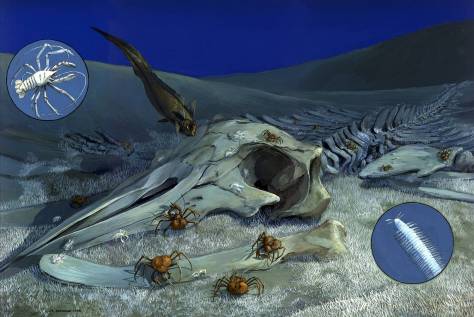Have you ever wondered what happens after the death of a whale? When a whale’s life ends, its body turn into a new ecosystem for many life forms. Do you want to learn more about whale falls? Which are the stages of a whale fall? Do you want to discover some incredible new species?
INTRODUCTION
Whales are amazing animals and they play a significant role in the marine ecosystems, as well as other cetacean species. Take the humpback whale for instance. This species feeds using a unique system called the net bubble method, in which seabirds can take advantage of it due to the fact that whales drive prey to the surface. Another key role they play is the transport of nutrients. Finally, another example is the one that we are going to explain in this post: the whale falls.
WHAT IS A WHALE FALL?
Whale corpses are known to serve as a host for animals that live in the bottom of the oceans. When the whale carcasses fall to the bottom of the sea, concretely in the bathyal or abyssal zone (at depths of 2,000 m or more), they are called whale falls. These animals take benefit from the dead whales since they serve as a source of food for them.

It is believed that whale falls may have provided a stepping stone for deep-sea species to colonise the sea floor. In addition, the more research, the more new species described and the more potential commercial applications.
STAGES OF COLONIZATION
A dead whale creates by itself a new and rich ecosystem because produces intense organic enrichment in a very small area. After this, successive stages of colonization take place. Species found in these areas are similar to those in hydrothermal vents. According to researchers, whale falls pass through three stages:
- Mobile scavengers stage
- The enrichment-opportunist stage
- Sulfophilic stage

It is thought that tens of thousands of organisms from about 400 animals species depend on a single whale fall. Astonishingly, scientists estimate that one whale corpse provides with the nutritional equivalent of 2,000-years worth of normal biological detritus sinking to the seafloor.
1. MOBILE SCAVENGERS STAGE
The first stage is dominated by mobile scavenger species. In this stage, the dead whale is covered by a dense aggregaton of hagfishes, small numbers of lithodid crabs, rattail fish, large sleeper sharks and millions of amphipods.
These animals are responsible of the disappearance of the soft tissue. They can eat 40-60 kg per day. In a 5-ton carcass, it lasted for 4 months, while in 35-tone carcasses for 9 months to 2 years.

2. THE ENRICHMENT-OPPORTUNIST STAGE
During the second stage, the animal’s skeleton is surrounded by dense aggregations of polychaete worms, cumaceans (crustaceans) and molluscs such as snails. There have been described some whale fall specialist species, previously unknown. These animals feed on the rest of the body, including the sediment surrounding because it is full of decomposing tissue.

3. SULFOPHILIC STAGE
This is by far the longest stage in whale falls: it might last from 10 to 50 years, or more. The so-called sulfophilic stage owes its name to the sulfide produced by bones due to the action of chemosynthetic bacteria, who use sulfate to break down the lipids inside the bones and produce sulfide. The sulfide allow the presence of dense bacterial mats, mussels and tube worms, among others. It have been found more than 30,000 organisms in a single skeleton.

NEW SPECIES DISCOVERED
As it has been mentioned above, new species have been described in whale falls. In this section, we are going to present only some of them.
The anemone Anthosactis pearsea is a small, white and cube-shaped species. Its importance lies on the fact that it is the first anemone found on a whale fall.

Species included in the genus Osedax have also been discovered. Their common name, bone-eating zombie worms, reflects exactly their task: to eat bones. These animals have neither eyes nor mouth, but they present reddish plumes that act as gills and some kind of green roots, where symbiotic bacteria break down proteins and lipids inside the bone, which supply nutrients for the worms. The macroscopic form of the animals is always a female, who contains dozens of microscopic males inside its body

Another strikingly awesome worm is the bristleworm, Ophryotrocha craigsmithi. In spite of lacking any particular adaptation, it is thought that they are exclusive at whale falls or similar ecosystems.

A final example to take into consideration is the gastropod Rubyspira, whale-fall specialists molluscs which are 3-4 cm in length.

I encourage you to watch these videos about whale falls. In the first one, you can see a diving on the Rosebud whale fall carried out by the team of E/V Nautilus, searching for the life it supports. In the second one, you can see a feast in the deep in a whale fall in Monterey Canyon, recorded by the Monterey Bay Aquarium Research Institute (MBARI).
REFERENCES
- Ballance, L.T (2009). Cetacean Ecology. In Perrin, W.F; Würsig, B & Thewissen, J.G.M (Editors). Encyclopedia of Marine Mammals. (pp. 196-201). Oxford: Elsevier
- Hermanus Online: Whale Fall – the strange ecosystem in the ocean
- Live Science: New creature found living in dead whale
- Live Science: New worm species discovered on dead whales
- Live Science: Strange worms discovered eating dead whales
- Monterey Bay Aquarium Research Institute: Whale carcass yields bone-devouring worms
- NOAA’s Undersea Research Program: This Whale’s (After) Life
- Paulo et al. (2016). Deep-sea whale fall fauna from the Atlantic resembles that on the Pacific Ocean. Nature. doi:10.1038/srep22139
- Cover picture: Nautilus Live



2 pensaments sobre “What lies beyond the death of a whale?”